中国汉字英文版介绍
- 格式:ppt
- 大小:1.43 MB
- 文档页数:11
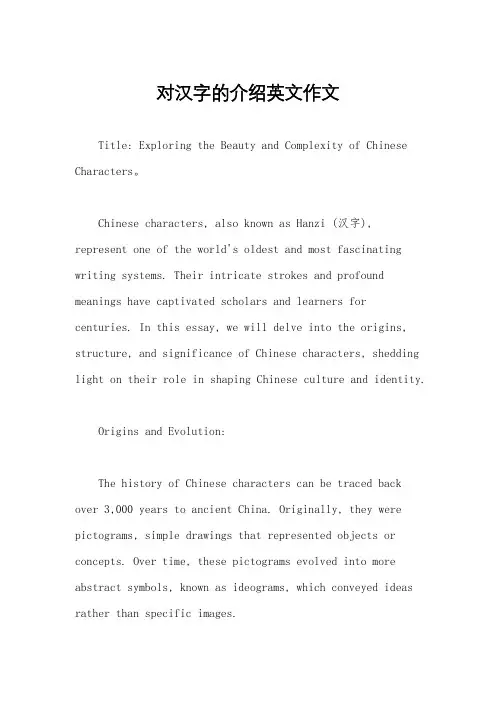
对汉字的介绍英文作文Title: Exploring the Beauty and Complexity of Chinese Characters。
Chinese characters, also known as Hanzi (汉字), represent one of the world's oldest and most fascinating writing systems. Their intricate strokes and profound meanings have captivated scholars and learners for centuries. In this essay, we will delve into the origins, structure, and significance of Chinese characters, shedding light on their role in shaping Chinese culture and identity.Origins and Evolution:The history of Chinese characters can be traced back over 3,000 years to ancient China. Originally, they were pictograms, simple drawings that represented objects or concepts. Over time, these pictograms evolved into more abstract symbols, known as ideograms, which conveyed ideas rather than specific images.One of the earliest forms of Chinese writing is found on oracle bones and bronze vessels dating back to the Shang Dynasty (1600–1046 BCE). These inscriptions provide valuable insights into the language and culture of ancient China. As civilization progressed, the script underwent numerous reforms and standardizations, leading to the establishment of the modern Chinese writing system.Structure and Composition:Chinese characters are composed of strokes, basic units of writing that are combined to form complex characters. There are eight basic types of strokes, includinghorizontal lines, vertical lines, and hooks, each of which contributes to the unique appearance of a character.Characters are typically organized into radicals, fundamental components that carry semantic or phonetic meaning. Radicals serve as building blocks for more complex characters and play a crucial role in character classification and dictionary lookup. For example, thecharacter 水(shuǐ), meaning "water," consists of the radical 氵, which indicates its semantic category.Semantic and Phonetic Elements:Chinese characters often contain both semantic and phonetic elements, allowing for a balance between meaning and pronunciation. Semantic radicals provide clues to the character's meaning, while phonetic components indicate its pronunciation. This dual structure enables Chinese speakers to infer the meaning and pronunciation of unfamiliar characters based on their existing knowledge of the language.For instance, consider the character 妈 (mā), meaning "mother." It consists of the radical 女(nǚ), meaning "woman," and the phonetic component 马(mǎ), which sounds similar to the character's pronunciation.Cultural Significance:Chinese characters are more than just a means ofcommunication; they embody the richness and diversity of Chinese culture. Through their intricate designs and nuanced meanings, characters reflect the values, beliefs, and history of the Chinese people.Moreover, Chinese characters play a vital role in preserving cultural heritage and promoting national identity. They are an integral part of traditional art forms such as calligraphy and seal carving, which require precision, discipline, and aesthetic sensitivity. By mastering these art forms, individuals can deepen their understanding of Chinese culture and express theircreativity through the written word.Challenges and Opportunities:While Chinese characters offer a window into the past and a gateway to cultural exploration, they also present challenges for learners, both native and non-native. The sheer number of characters, estimated to be over 50,000, can be daunting for beginners, requiring years of study and practice to achieve proficiency.However, advancements in technology have made learning Chinese characters more accessible than ever before. Mobile apps, online courses, and digital flashcards provide interactive tools for learners to practice writing, reading, and memorizing characters. Additionally, machine learning algorithms can assist in character recognition and language processing, facilitating communication between speakers of different languages.Conclusion:In conclusion, Chinese characters represent a unique blend of art, language, and culture, encompassing thousands of years of history and tradition. Their intricate structure, rich symbolism, and cultural significance make them a subject of fascination and admiration worldwide. By studying Chinese characters, we gain not only linguistic proficiency but also a deeper appreciation for the enduring legacy of Chinese civilization. As we continue to explore the beauty and complexity of Hanzi, we unlock new insightsinto the human capacity for creativity, expression, and communication across time and space.。
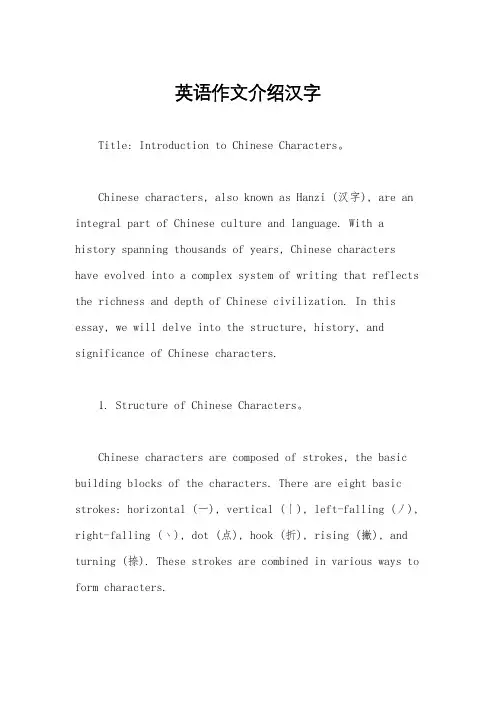
英语作文介绍汉字Title: Introduction to Chinese Characters。
Chinese characters, also known as Hanzi (汉字), are an integral part of Chinese culture and language. With a history spanning thousands of years, Chinese characters have evolved into a complex system of writing that reflects the richness and depth of Chinese civilization. In this essay, we will delve into the structure, history, and significance of Chinese characters.1. Structure of Chinese Characters。
Chinese characters are composed of strokes, the basic building blocks of the characters. There are eight basic strokes: horizontal (一), vertical (丨), left-falling (丿), right-falling (丶), dot (点), hook (折), rising (撇), and turning (捺). These strokes are combined in various ways to form characters.Characters are typically organized into radicals, which are components that give clues to the meaning or pronunciation of the character. Radicals can be thought of as the "building blocks" of characters. For example, the character 水(shuǐ), meaning "water," consists of the radical 氵, which indicates water-related meanings.2. History of Chinese Characters。
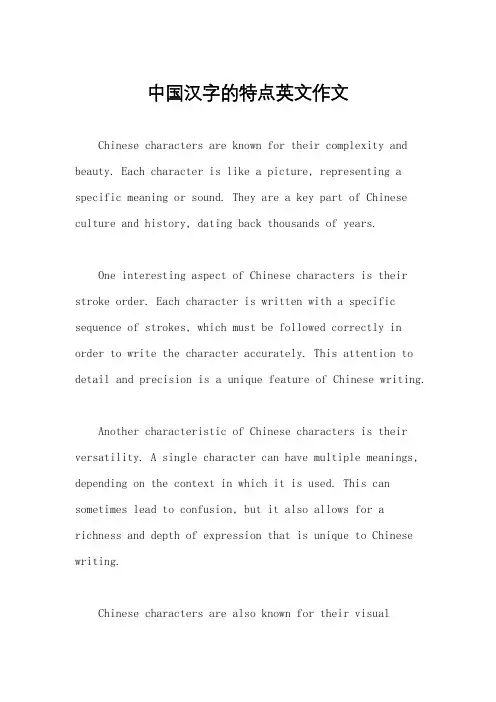
中国汉字的特点英文作文Chinese characters are known for their complexity and beauty. Each character is like a picture, representing a specific meaning or sound. They are a key part of Chinese culture and history, dating back thousands of years.One interesting aspect of Chinese characters is their stroke order. Each character is written with a specific sequence of strokes, which must be followed correctly in order to write the character accurately. This attention to detail and precision is a unique feature of Chinese writing.Another characteristic of Chinese characters is their versatility. A single character can have multiple meanings, depending on the context in which it is used. This can sometimes lead to confusion, but it also allows for a richness and depth of expression that is unique to Chinese writing.Chinese characters are also known for their visualappeal. The intricate strokes and patterns create a sense of artistry that is lacking in many other writing systems. Calligraphy, the art of writing characters with brush and ink, is a highly respected and admired skill in Chinese culture.Despite their complexity, Chinese characters are still widely used in modern times. They are used in written communication, signage, and even in digital media. The ability to read and write Chinese characters is considered a valuable skill, and many people around the world study them for this reason.In conclusion, Chinese characters are a fascinating and unique aspect of Chinese culture. Their complexity, beauty, and versatility make them a truly special form of writing. Learning to read and write Chinese characters is a challenging but rewarding experience that offers insight into the rich history and culture of China.。
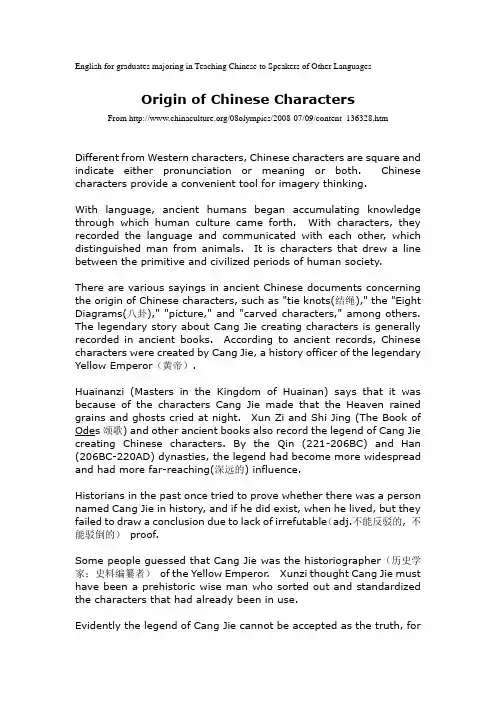
English for graduates majoring in Teaching Chinese to Speakers of Other LanguagesOrigin of Chinese CharactersFrom /08olympics/2008-07/09/content_136328.htm Different from Western characters, Chinese characters are square and indicate either pronunciation or meaning or both. Chinese characters provide a convenient tool for imagery thinking.With language, ancient humans began accumulating knowledge through which human culture came forth. With characters, they recorded the language and communicated with each other, which distinguished man from animals. It is characters that drew a line between the primitive and civilized periods of human society.There are various sayings in ancient Chinese documents concerning the origin of Chinese characters, such as "tie knots(结绳)," the "Eight Diagrams(八卦)," "picture," and "carved characters," among others. The legendary story about Cang Jie creating characters is generally recorded in ancient books. According to ancient records, Chinese characters were created by Cang Jie, a history officer of the legendary Yellow Emperor(黄帝).Huainanzi (Masters in the Kingdom of Huainan) says that it was because of the characters Cang Jie made that the Heaven rained grains and ghosts cried at night. Xun Zi and Shi Jing (The Book of Odes颂歌) and other ancient books also record the legend of Cang Jie creating Chinese characters. By the Qin (221-206BC) and Han (206BC-220AD) dynasties, the legend had become more widespread and had more far-reaching(深远的) influence.Historians in the past once tried to prove whether there was a person named Cang Jie in history, and if he did exist, when he lived, but they failed to draw a conclusion due to lack of irrefutable(adj.不能反驳的, 不能驳倒的)proof.Some people guessed that Cang Jie was the historiographer(历史学家;史料编纂者)of the Yellow Emperor. Xunzi thought Cang Jie must have been a prehistoric wise man who sorted out and standardized the characters that had already been in use.Evidently the legend of Cang Jie cannot be accepted as the truth, forany script can only be a creation developed by people to meet the needs of social life over a long period of trial and experiment. Chinese characters are a huge and complicated system, and they could only have come into being after a long period of creation and development.According to modern researchers, the ancestors of the Chinese people tied knots in rope to record events. Later, they adopted sharp weapons to inscribe(雕、刻)signs, and developed the earliest form of Chinese characters. Archeologists(考古学家)have found inscribed signs on Neolithic(['niə'lɪθɪk]新石器时代的)pottery(陶器)shards(碎片)in Banpo Village in Shaanxi Province. These signs, dating back to some 6,000 years ago, were possibly the seeds of later Chinese characters.Inscribed signs, a little younger than those found in Banpo Village, were also found on pottery along the lower reaches of the Yellow River (黄河下游). There, archeologists found a sign with shapes of the moon and a five-peak mountain underneath a circle. Experts in ancient characters say the pictograph(['pɪktəgrɑːf] n.象形文字, 古代石壁画)symbolizes the interval(距离,间隔)in which the moon disappears and the sun rises. Mythology([mɪ'θɒlədʒɪ]神话学)researchers have another interpretation. Their understanding is that the moon shape symbolizes the red clouds as the sun rises, and thus the picture portrays([pɔː'treɪ]描绘)a sunrise over the sea.Most of the signs inscribed on pottery were painted red, creating an imposing(adj.使人难忘的, 壮丽的)and mysterious impression. The hypothesis is that pictographs were used in sacrificial rituals(['rɪtʃʊəl]宗教仪式)dedicated to(献给)the sunrise or as prayers for good harvests. They were inscribed in an orderly way, and the strokes(笔画)are full of strength. Similar signs and designs have been found in other regions in China, indicating they had become generally recognized. These are the earliest symbols, or pictographs, in China and are more than 5,000 years old.In Qinghai Province in western China, pottery objects of approximately the same period and inscribed with images of birds, insects and animals have been unearthed(掘出). These, too, are regarded as pictographs. According to philologist(文献学者;语言学者)Tang Lan(唐兰), Chinese characters originated from pictures; The older the characters, the more they look like pictures. Since pictures have no fixed forms, the ancient Chinese characters were generally free in form.Xu Shen, a philologist of the Han Dynasty (206BC-220AD), divided Chinese characters into six categories. Modern scholars have since reduced them to three types, of which the pictographic character is one. The picture signs are the embryos(['embrɪəʊ]胚胎)of both calligraphy and painting, which gave rise to the Chinese saying that calligraphy and painting have the same origin. At first, the pictographic characters differed from region to region. As time went by, however, they become more standardized, abstract and united, and the earliest Chinese written language, Jiaguwen (shell and bone writing) appeared.Very important website: /index.htmNote: omniglot=omni+glot;omni=(Greek) all;glot=(Greek) language (see English glossary);omniglot=all languages.Origins of writing in ChinaFrom /writing/chinese.htmMost linguists believe that writing was invented in China during the latter half of the 2nd millennium BC and that there is no evidence to suggest the transmission of writing from elsewhere. The earliest recognizable examples of written Chinese date from 1500-950 BC (Shang dynasty) and were inscribed on ox scapulae and turtle shells - "oracle bones".In 1899 a scholar from Beijing named Wang Yirong noticed symbols that looked like writing on some "dragon bones" which he had been prescribed by a pharmacy. At that time "dragon bones" were often used in Chinese medicine and were usually animal fossils. Many more "oracle bones" were found in the ruins of the Shang capital near Anyang in the north of Henan province.The script on these "oracle bones" is known as 甲骨文(jiăgŭwén) - literally "shell bone writing". They were used for divination, a process which involved heating them then inspecting the resulting cracks to determine to answers to one's questions. The bones were then inscribed with details of the questions and the answers. Most of the questions involved hunting, warfare, the weather and the selection of auspicious days for ceremonies.A collection of oracle bones in the National Palace Museum near Taipei.Recently archaeologists in China have unearthed many fragments of neolithic pottery, the oldest of which date from about 4800 BC, inscribed with symbols which could be a form of writing. None of these symbols resemble any of the Shang characters and the likelyhood of deciphering them is remote given the paucity of material.The Chinese writing systemChinese is written with characters which are known as 漢字[汉字] (hànzi). The characters were originally pictures of people, animals or other things, but over the centuries they have become increasingly stylized and no longer resemble the things they represent. Many characters have been combined with others to create new ones.Until the early 20th century, Classical Chinese, 文言(wényán), was the main form of writing in China. It was standardized during the late Han Dynasty (25-220 AD) and was also used in Korea, Japan and Vietnam before they developed their own writing systems.In Classical Chinese most words were monosyllabic and written with a single character. However, during the 1920s a new form of written Chinese modelled on spoken Mandarin was developed. Most Chinese publications since then have been written in this form, which is known as 白話[白话] (báihuà), though Classical Chinese constructions and especially proverbs are still used to some extent.In spoken Chinese, words are made up of one, two or more syllables. Each of the syllables is written with a separate character. Each character has its own meaning, though many are used only in combination with other characters.Every character is given exactly the same amount of space, no matter how complex it is. There are no spaces between characters and the characters which make up multi-syllable words are not grouped together, so when reading Chinese, you not only have to work out what the characters mean and how to pronounce them, but also which characters belong together.How many characters?The Chinese writing system is an open-ended one, meaning that there is no upper limit to the number of characters. The largest Chinese dictionaries include about 56,000 characters, but most of them are archaic, obscure or rare variant forms. Knowledge of about 3,000 characters enables you to read about 99% of the characters used in Chinese newspapers and magazines. To read Chinese literature, technical writings or Classical Chinese though, you need to be familiar with at least 6,000 characters.UsageCharacters can be used on their own, in combination with other characters or as part of other characters.StrokesFrom /writing/chinese.htmChinese characters are written with the following twelve basic strokes:A character may consist of between 1 and 64 stokes. The strokes are always written in the same direction and there is a set(固定的)order to write the strokes of each character. In dictionaries, characters are ordered partly by the number of stokes they contain.NotesThe 39-stroke character (3 x thunder) means "the sound of thunder" and is always written doubled (靐靐). The 48-stroke character (3 dragons) means "the appearance of a dragon walking".HomophonesThere are approximately 1,700 possible syllables in Mandarin, which compares with over 8,000 in English. As a result, there are many homophones - syllables which sound the same but mean different things. These are distinguished in written Chinese by using different characters for each one.Not all the following characters are pronounced with the same tone, so to Chinese ears they sound different. To Western ears however they all sound the same. These syllables can be distinguished in speech from the context and because most of them usually appear in combination with other syllables.If you look closely, you will notice that some of the characters above have parts in common. These parts give you a clue to how to pronounce the characters.More examples of homophonesIt is even possible to write a text in Chinese using on one sound, pronounced with different tones, of course. This is exactly what Chinese linguist, Zhao Yuanren, did when he wrote the "Story of Shi Eating the Lions" using nothing but the sound 'shi'. The story makes sense in written form, but is impossible to understand when read aloud.You can see and hear the story on:/onlinelit/stonelion.html施氏食獅史shi1 shi4 shi2 shi1 shi3Story of Shi Eating the Lions石室詩士施氏, shi2 shi4 shi1 shi4 shi1shi4,A poet named Shi lived in a stone room,嗜獅,誓食十獅. shi4 shi1, shi4 shi2 shi2shi1.fond of lions, he swore that he would eat tenlions.氏時時適市視獅. shi4 shi2 shi2 shi4 shi4shi4 shi1.He constantly went to the market to look forten lions.十時,適十獅適市. shi2 shi2, shi4 shi2 shi1shi4 shi4.At ten o'clock, ten lions came to the market是時,適施氏適是市. shi4 shi2, shi4 shi1 shi4shi4 shi4 shi4.and Shi went to the market.氏視是十獅,恃矢勢, shi4 shi4 shi4 shi2 shi1,shi4 shi3 shi4,Looking at the ten lions, he relied on hisarrows使是十獅逝世. shi3 shi4 shi2 shi1 shi4shi4.to cause the ten lions to pass away.氏拾是十獅屍, 適石室. shi4 shi2 shi4 shi2 shi1shi1, shi4 shi2 shi4.Shi picked up the corpses of the ten lions andtook them to his stone room.石室濕,氏使侍拭石室. shi2 shi4, shi1, shi4 shi3shi4 shi4 shi2 shi4.The stone room was damp. Shi ordered aservant to wipe the stone room.石室拭,氏始試食十獅屍. shi2 shi4 shi4, shi4 shi3shi4 shi2 shi2 shi1 shi1.As the stone den was being wiped, Shi beganto try to eat the meat of the ten lions.食時, 始識十獅屍, shi2 shi2, shi3 shi4 shi4shi2 shi1 shi1,At the time of the meal, he began to realizethat the ten lion corpses實十石獅屍. shi2 shi2 shi2 shi1 shi1. were in fact were ten stone lions.試釋是事. shi4 shi4 shi4 shi4 Try to explain this matter.Compound wordsChinese verbs and adjectives generally consist of one character (syllable) but nouns often consist of two, three or more characters (syllables):Simplified Chinese charactersThe Simplified script (a.k.a.<also known as又名> Simplified Chinese) was officially adopted in the People's Republic of China in 1949 in an effort to eradicate(根除)illiteracy. The simplified script is also used in Singapore but the older traditional characters are still used in Taiwan, Hong Kong, Macau and Malaysia.A second round of simplifications which was published in 1977 but proved very unpopular and was abandoned in 1986.About 2,000 characters have been simplified in a number of different ways (the simplified characters are shown in red):Many simplified characters are based on commonly used abbreviations:Others retain only one part from the traditional character.Some replace the phonetic element of the traditional character with a simpler one that is pronounced in the same or in a similar way:In some cases, several traditional characters are represented by one simplified character:Recently the traditional characters have started to make a come back, particularly in southern China.Sample text in ChineseHànyŭ pīnyīn transliterationRénrén shēng ér zìyóu, zài zūnyán hé quánlì shàng yīlǜpíngdĕng. Tāmen fùyŏu lĭxìng hé liángxīn, bìng yīng yĭ xiōngdì guānxì de jīngshén hùxiāng duìdài.Direction of writingTraditionally Chinese was written from right to left in vertical columns. The first publication in Chinese using horizontal (left to right) text was Robert Morrison's Dictionary of the Chinese language, published in 1815–1823 in Macau. The increasing use of words in Western languages, especially English, in Chinese texts from the early 20th century made horizontal texts more popular.Since 1949 horizontal writing has become the standard in the PRC, and all PRC newspapers changed from vertical to horizontal text in 1956, though some headlines are written vertically, as are inscriptions(题字)of signs on most state organizations.The horizontal writing of Chinese is normal in Singapore, and it has been gradually adopted in Hong Kong, Macao and in overseas Chinese communities since the 1990s.Vertical text remains popular in Taiwan however, though horizontal text is used as well. In Taiwan newspapers and magazines with vertical text, some of the headlines and titles are written horizontally right to left across the top of the main text.Use of Chinese characters for other languagesChinese characters are used to write Modern Standard Chinese, which is based largely on spoken Mandarin. Other varieties of Chinese, especially Cantonese, are sometimes written with Chinese characters, or with a combination of characters and words in the Latin alphabet. Some of the characters used are archaic(陈旧的,古老的)or invented specifically for these languages.Chinese characters have been used to write Japanese and Korean and Vietnamese. They are still used in written Japanese, in combination with hiragana(平假名-日文字母的草体)and katakana(片假名), and to a much lesser in written Korean, while Vietnamese is now written with the Latin alphabet.Evolution of Chinese CharactersFrom /writing/chinese_evolution.htmThe images(图象)below illustrate how a number of Chinese characters have changed over time from their earliest known pictographic(象形文字的)forms, to the versions used today.The Large Seal and Small Seal scripts are still used to write names on personal name chops(官印), and are also occasionally used to write company names on buildings, stationery(文具), name cards, etc.The Grass script (a.k.a. <also known as又名> Cursive script) is used mainly for Chinese calligraphy. Each character is written with one continuous stroke, which enables very rapid writing, though characters written in this way are difficult to read. Legibility(易辨性)is not a primary concern for Chinese calligraphers, instead they aim to produce calligraphy that is aesthetically(审美地)pleasing.The Simplified script(a.k.a. Simplified Chinese), was officially adopted in the People's Republic of China in 1949 in an effort to eradicate illiteracy. It is also used in Singapore.Sample textsSmall Seal Script (小篆)Clerical Script (隸書)Standard Script with zhùyīn fúhào (楷書)Running script (行書)Grass scriptSimplified characters (简体字)。

向外国人介绍汉字英语作文English Answer:Chinese characters, also known as hanzi, are thewritten form of the Chinese language. They are one of the oldest and most complex writing systems in the world, and they are used to write not only Chinese, but also other languages such as Japanese, Korean, and Vietnamese.There are two main types of Chinese characters: pictographs and ideographs. Pictographs are characters that represent objects or ideas by drawing a picture of them. For example, the character for "sun" is a picture of the sun. Ideographs are characters that represent abstract concepts or ideas. For example, the character for "love" is a combination of the characters for "heart" and "person."Chinese characters are written in columns, from top to bottom and from right to left. Each character is usually composed of several strokes, and there are specific rulesfor how these strokes are written. The order of the strokes is important, as writing a character in the wrong order can change its meaning.There are over 50,000 Chinese characters, but most people only need to know a few thousand to be able to read and write Chinese. The most common characters are used in everyday language, while the less common characters areused in more specialized contexts, such as in literature, science, and law.Learning to write Chinese characters can be challenging, but it is also a rewarding experience. Once you have mastered the basics, you will be able to read and write one of the most beautiful and expressive languages in the world.中文回答:汉字是中国语言的书面形式。
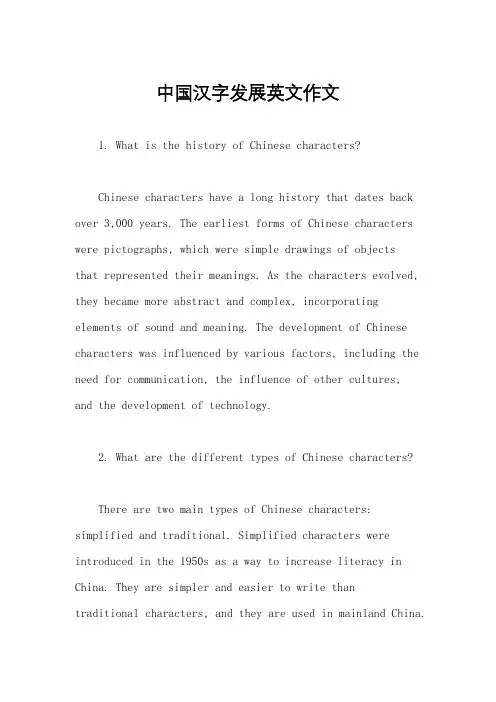
中国汉字发展英文作文1. What is the history of Chinese characters?Chinese characters have a long history that dates back over 3,000 years. The earliest forms of Chinese characters were pictographs, which were simple drawings of objectsthat represented their meanings. As the characters evolved, they became more abstract and complex, incorporating elements of sound and meaning. The development of Chinese characters was influenced by various factors, including the need for communication, the influence of other cultures,and the development of technology.2. What are the different types of Chinese characters?There are two main types of Chinese characters: simplified and traditional. Simplified characters were introduced in the 1950s as a way to increase literacy in China. They are simpler and easier to write thantraditional characters, and they are used in mainland China.Traditional characters are used in Taiwan, Hong Kong, and other parts of the world. They are more complex anddifficult to write, but they are considered to be more aesthetically pleasing.3. How are Chinese characters used today?Chinese characters are still used extensively in China, Taiwan, and other parts of the world. They are used for writing and reading Chinese, and they are also used in calligraphy, art, and other forms of expression. In addition, Chinese characters are used in many other languages, including Japanese, Korean, and Vietnamese,where they are used to represent Chinese loanwords andnative words.4. What are some challenges of learning Chinese characters?Learning Chinese characters can be a challenge for non-native speakers. There are thousands of characters to learn, each with its own unique meaning and pronunciation. Inaddition, Chinese characters are not phonetic, which means that the pronunciation of a character cannot be determined by its spelling. Instead, learners must memorize the pronunciation of each character separately. However, with practice and dedication, it is possible to become proficient in reading and writing Chinese characters.。
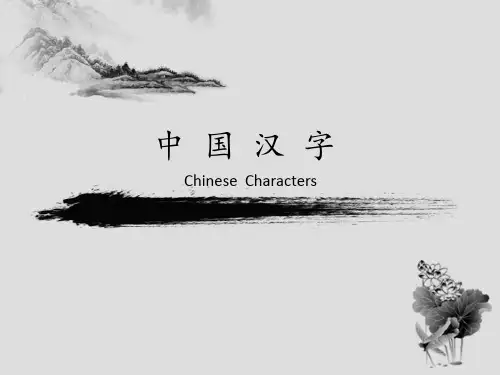
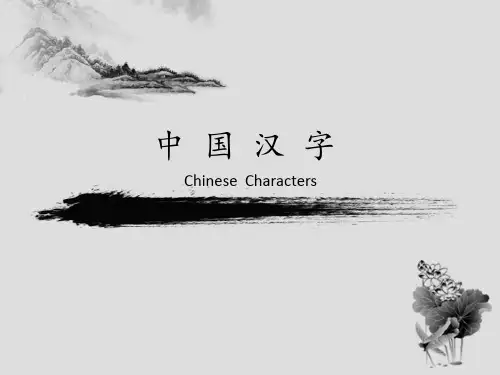
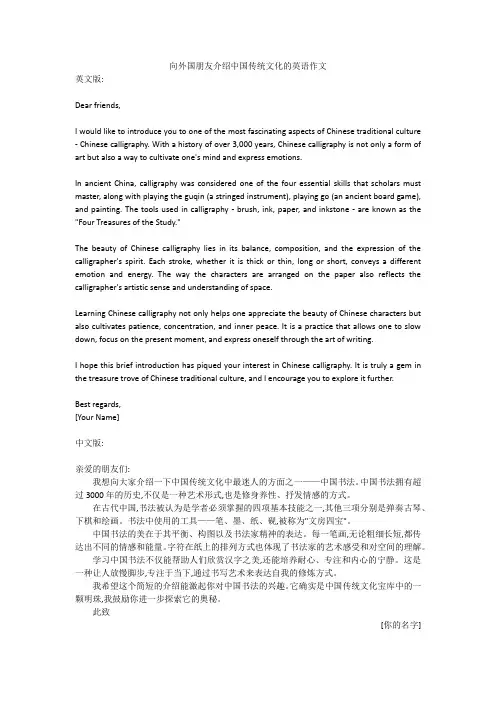
向外国朋友介绍中国传统文化的英语作文英文版:Dear friends,I would like to introduce you to one of the most fascinating aspects of Chinese traditional culture - Chinese calligraphy. With a history of over 3,000 years, Chinese calligraphy is not only a form of art but also a way to cultivate one's mind and express emotions.In ancient China, calligraphy was considered one of the four essential skills that scholars must master, along with playing the guqin (a stringed instrument), playing go (an ancient board game), and painting. The tools used in calligraphy - brush, ink, paper, and inkstone - are known as the "Four Treasures of the Study."The beauty of Chinese calligraphy lies in its balance, composition, and the expression of the calligrapher's spirit. Each stroke, whether it is thick or thin, long or short, conveys a different emotion and energy. The way the characters are arranged on the paper also reflects the calligrapher's artistic sense and understanding of space.Learning Chinese calligraphy not only helps one appreciate the beauty of Chinese characters but also cultivates patience, concentration, and inner peace. It is a practice that allows one to slow down, focus on the present moment, and express oneself through the art of writing.I hope this brief introduction has piqued your interest in Chinese calligraphy. It is truly a gem in the treasure trove of Chinese traditional culture, and I encourage you to explore it further.Best regards,[Your Name]中文版:亲爱的朋友们:我想向大家介绍一下中国传统文化中最迷人的方面之一——中国书法。
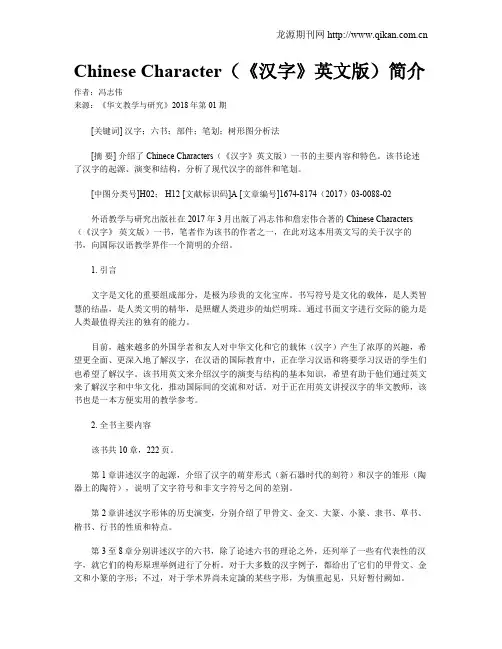
Chinese Character(《汉字》英文版)简介作者:冯志伟来源:《华文教学与研究》2018年第01期[关键词] 汉字;六书;部件;笔划;树形图分析法[摘要] 介绍了Chinece Characters(《汉字》英文版)一书的主要内容和特色。
该书论述了汉字的起源、演变和结构,分析了现代汉字的部件和笔划。
[中图分类号]H02; H12 [文献标识码]A [文章编号]1674-8174(2017)03-0088-02外语教学与研究出版社在2017年3月出版了冯志伟和詹宏伟合著的Chinese Characters (《汉字》英文版)一书,笔者作为该书的作者之一,在此对这本用英文写的关于汉字的书,向国际汉语教学界作一个简明的介绍。
1. 引言文字是文化的重要组成部分,是极为珍贵的文化宝库。
书写符号是文化的载体,是人类智慧的结晶,是人类文明的精华,是照耀人类进步的灿烂明珠。
通过书面文字进行交际的能力是人类最值得关注的独有的能力。
目前,越来越多的外国学者和友人对中华文化和它的载体(汉字)产生了浓厚的兴趣,希望更全面、更深入地了解汉字,在汉语的国际教育中,正在学习汉语和将要学习汉语的学生们也希望了解汉字。
该书用英文来介绍汉字的演变与结构的基本知识,希望有助于他们通过英文来了解汉字和中华文化,推动国际间的交流和对话。
对于正在用英文讲授汉字的华文教师,该书也是一本方便实用的教学参考。
2. 全书主要内容该书共10章,222页。
第1章讲述汉字的起源,介绍了汉字的萌芽形式(新石器时代的刻符)和汉字的雏形(陶器上的陶符),说明了文字符号和非文字符号之间的差别。
第2章讲述汉字形体的历史演变,分别介绍了甲骨文、金文、大篆、小篆、隶书、草书、楷书、行书的性质和特点。
第3至8章分别讲述汉字的六书,除了论述六书的理论之外,还列举了一些有代表性的汉字,就它们的构形原理举例进行了分析。
对于大多数的汉字例子,都给出了它们的甲骨文、金文和小篆的字形;不过,对于学术界尚未定論的某些字形,为慎重起见,只好暂付阙如。
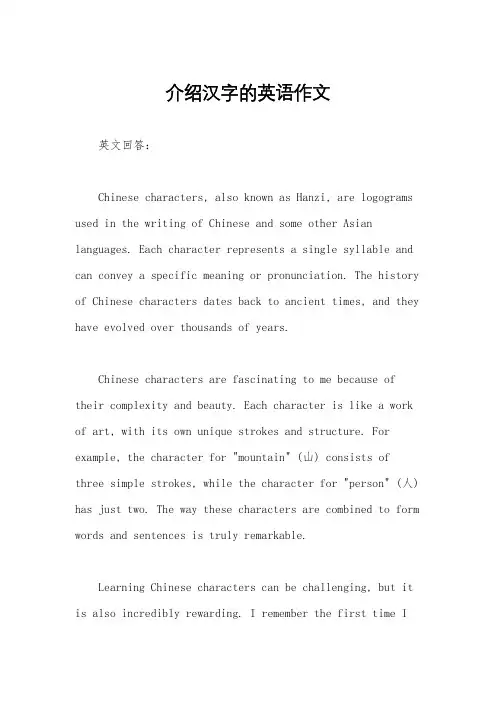
介绍汉字的英语作文英文回答:Chinese characters, also known as Hanzi, are logograms used in the writing of Chinese and some other Asian languages. Each character represents a single syllable and can convey a specific meaning or pronunciation. The history of Chinese characters dates back to ancient times, and they have evolved over thousands of years.Chinese characters are fascinating to me because of their complexity and beauty. Each character is like a work of art, with its own unique strokes and structure. For example, the character for "mountain" (山) consists of three simple strokes, while the character for "person" (人) has just two. The way these characters are combined to form words and sentences is truly remarkable.Learning Chinese characters can be challenging, but it is also incredibly rewarding. I remember the first time Isuccessfully wrote a simple character like "大" (big) or "小" (small), and I felt a sense of accomplishment. As I continued to study, I began to recognize more and more characters in everyday life, from street signs to restaurant menus.中文回答:汉字,也称为汉字,是用于书写中文和一些其他亚洲语言的表意文字。
介绍汉字的英语作文Title: Exploring the Beauty and Complexity of Chinese Characters。
Chinese characters, often referred to as Hanzi, are one of the oldest writing systems in the world, dating back thousands of years. They are not only a means of communication but also a reflection of Chinese culture, history, and philosophy. In this essay, we will delve into the intricacies of Chinese characters, exploring their structure, evolution, and significance.First and foremost, Chinese characters are logograms, which means each character represents a word or ameaningful unit of language, rather than a sound like in alphabetic writing systems. This feature makes Chinese writing visually distinctive and rich in meaning. 。
The structure of Chinese characters is based on strokes, which are basic units of writing. Each character iscomposed of one or more strokes arranged in a specific order. Understanding stroke order is crucial for writing Chinese characters correctly and efficiently. There areeight basic strokes in Chinese calligraphy, including horizontal (一), vertical (丨), dot (丶), hook (亅), horizontal hook (乛), vertical hook (乚), left-falling (丿), and right-falling (乀). By combining these strokes in various ways, thousands of characters can be created.Moreover, Chinese characters have undergone significant evolution throughout history. The earliest known Chinese characters date back to the Shang dynasty (1600–1046 BCE) and were inscribed on oracle bones and bronze vessels for divination purposes. Over time, the script evolved into different styles, such as seal script, clerical script, regular script, cursive script, and running script. Each style has its own unique characteristics and aesthetic appeal, reflecting the cultural and artistic preferences of different periods.Furthermore, Chinese characters are deeply intertwined with Chinese culture and philosophy. Many characters arepictographic, meaning they are based on images of real objects. For example, the character for "mountain" (山) resembles three peaks, while the character for "sun" (日) resembles a circle with a dot in the center. Other characters are ideographic, representing abstract concepts or ideas. For instance, the character for "peace" (平) consists of the radical for "roof" (宀) over the radicalfor "one" (一), suggesting the concept of "tranquility under one roof." 。
汉字中国英文作文China, a country with a long history and rich culture, has always fascinated me. The intricate characters of the Chinese language, the delicious cuisine, and thetraditional festivals all contribute to the unique charm of this ancient civilization.The Great Wall, a symbol of China's ancientcivilization and a testament to the ingenuity of the Chinese people, is a must-see for anyone visiting the country. The sheer magnitude and grandeur of this architectural marvel are truly awe-inspiring.Chinese calligraphy, with its graceful strokes and elegant forms, is a true art form that embodies the beauty and sophistication of the Chinese culture. The rhythmic movements of the brush as it glides across the paper create a sense of harmony and balance that is truly mesmerizing.The bustling streets of Beijing, with their mix ofmodern skyscrapers and ancient temples, are a sight to behold. The juxtaposition of old and new, traditional and contemporary, creates a dynamic energy that is palpable in the air.The traditional Chinese tea ceremony, with its meticulous attention to detail and emphasis on mindfulness, is a reflection of the Chinese philosophy of harmony and balance. The ritual of preparing and serving tea is a meditative practice that fosters a sense of tranquility and inner peace.The terracotta warriors, an army of life-sized clay soldiers buried with the first Emperor of China, are a testament to the ancient Chinese belief in the afterlife. The sheer scale and craftsmanship of this archaeological wonder are a testament to the skill and dedication of the artisans who created them.The vibrant colors and intricate designs of traditional Chinese embroidery are a feast for the eyes. The meticulous attention to detail and the skillful use of differentstitching techniques create a sense of depth and texture that is truly remarkable.。
中国汉字来源的英语作文英文:The Chinese characters have a long and rich history,and their origin can be traced back to ancient times. The earliest Chinese characters can be found on oracle bonesand bronze inscriptions dating back to the Shang dynasty (c. 1600–1046 BC). These characters were pictograms, which means that they were originally based on simple drawings of objects. For example, the character for "mountain" (山) was originally a simple drawing of a mountain, and thecharacter for "sun" (日) was a drawing of the sun.As time passed, the characters became more stylized and abstract, and many of them evolved into the complex characters that we see today. One of the most fascinating aspects of Chinese characters is their ability to convey meaning through their visual appearance. For example, the character for "peace" (安) is a combination of the characters for "woman" (女) and "roof" (宀), which suggeststhe idea of a woman being safe and secure under a roof.Another interesting aspect of Chinese characters istheir phonetic components. Many characters are made up of a radical that indicates the general meaning of the character, and a phonetic component that hints at the pronunciation. For example, the character for "mother" (妈) has theradical for "woman" (女) and the phonetic component for "horse" (马), which gives a clue to its pronunciation.中文:中国汉字有着悠久而丰富的历史,其起源可以追溯到古代。
汉字中国英文作文China, a country with a long history and rich culture, is known for its diverse landscapes, delicious cuisine, and ancient traditions. From the bustling streets of Shanghai to the serene beauty of the Great Wall, there is something for everyone to explore and experience in this vast and vibrant nation.The Chinese language, with its intricate characters and tonal sounds, is a fascinating aspect of the country's culture. It is a language that is both challenging and beautiful, and learning it can open up a whole new world of communication and understanding.Traditional Chinese festivals, such as the Spring Festival and Mid-Autumn Festival, are deeply rooted in the country's history and are celebrated with colorful parades, lively dragon dances, and an abundance of delicious food. These festivals are a time for families to come together and honor their heritage.Chinese cuisine is famous worldwide for its boldflavors and diverse range of dishes. From spicy Sichuan hot pot to delicate Cantonese dim sum, there is no shortage of delicious food to try. Each region of China has its own unique culinary specialties, making it a paradise for food lovers.The ancient art of Chinese calligraphy is a revered form of expression, with each brushstroke carrying deep meaning and symbolism. It is a practice that requires patience, precision, and a deep appreciation for the beauty of written language.In recent years, China has become a global leader in technology and innovation, with companies like Alibaba and Huawei making significant contributions to the digital world. The country's rapid development has led to a dynamic and fast-paced society, where new ideas and trends are constantly emerging.The natural beauty of China is also a sight to behold,from the majestic peaks of the Himalayas to the tranquil waters of the Li River. The country's diverse landscapes offer a wealth of opportunities for outdoor enthusiasts and nature lovers.In conclusion, China is a country of immense diversity and cultural richness, with a history that stretches back thousands of years. It is a place where tradition and modernity coexist, creating a dynamic and fascinating society that continues to captivate the world.。
汉字中国英文作文China, a country with a long history and rich culture, is home to over 1.4 billion people. The Chinese language, with its unique characters and tones, is known for being one of the most difficult languages to learn.The Great Wall of China, a symbol of ancient Chinese civilization, stretches over 13,000 miles and is a must-see for tourists visiting the country. It's a testament to the ingenuity and determination of the Chinese people.Chinese cuisine is famous for its diverse flavors and ingredients. From spicy Sichuan dishes to delicate Cantonese dim sum, there's something for everyone to enjoy. And let's not forget about the iconic Peking duck, a dish that has been perfected over hundreds of years.Traditional Chinese medicine, with its focus onholistic healing and natural remedies, has been practiced for thousands of years. Acupuncture, herbal medicine, andqigong are just a few examples of the techniques used to maintain health and balance in the body.China's rapid economic growth and technological advancements have made it a global powerhouse. With companies like Alibaba, Huawei, and Tencent leading the way, China is at the forefront of innovation and entrepreneurship.The Chinese New Year, also known as the Spring Festival, is the most important traditional festival in China. It's a time for families to come together, share meals, and exchange red envelopes filled with money as a symbol ofgood luck and prosperity.The terracotta army, a collection of life-sized clay soldiers and horses, is one of the most significant archaeological discoveries in the world. It was created to protect the first emperor of China, Qin Shi Huang, in the afterlife.The panda, a national treasure of China, is adored bypeople all over the world. With its cute appearance and playful nature, it has become a symbol of wildlife conservation and environmental protection.Chinese calligraphy, with its graceful and artistic strokes, is considered a form of visual art and a reflection of the writer's personality. It's a traditional skill that requires patience, precision, and a deep understanding of the Chinese language.The Forbidden City, a UNESCO World Heritage site, was the imperial palace of the Ming and Qing dynasties. With its grand architecture and intricate design, it's a living museum that showcases the opulence and power of ancient China.。